| Srl | Item |
| 1 |
ID:
120633


|
|
|
|
|
| Publication |
2013.
|
| Summary/Abstract |
China has rapidly developed a sophisticated regionalism strategy in East Asia. Minimising the region's "China threat" perception has been a significant consideration in this strategy. Unfortunately, the ongoing escalation of tension concerning territorial disputes over the Diaoyutai / Senkaku Islands and the South China Sea, initiated by a series of high-profile naval exercises in the latter half of 2010, has reinforced the "China threat" perception and bolstered the hedging strategies of countries in the region. China is aware of its relative disadvantage, and it has been keeping its options open while allowing ASEAN to maintain the initiative.
|
|
|
|
|
|
|
|
|
|
|
|
|
|
|
|
| 2 |
ID:
152343


|
|
|
|
|
| Summary/Abstract |
Many middle powers in East Asia—particularly South Korea and Malaysia—are affected by the strategic relationship between the USA (hereafter the USA) and China. Therefore, I would like to examine the strategic behaviors of the middle powers in East Asia from a hedging strategy perspective. The hedging strategy extends the logic of the traditional balance of power theory while maintaining a strong emphasis on structural incentives, which critics have found lacking in the soft balance approach. Most East Asian states have calibrated their security measures and strategies in response to the changing US-China relationship. The purpose of this article is to compare the hedging strategies of South Korea and Malaysia, which are middle powers, that affect the East Asian security order. This article, thus, aims not simply to explain specific instances of the hedging strategies of middle powers but also, based on this theoretical foundation, to establish a new frame of analysis for the hedging strategies of middle powers through objective and critical assessment.
|
|
|
|
|
|
|
|
|
|
|
|
|
|
|
|